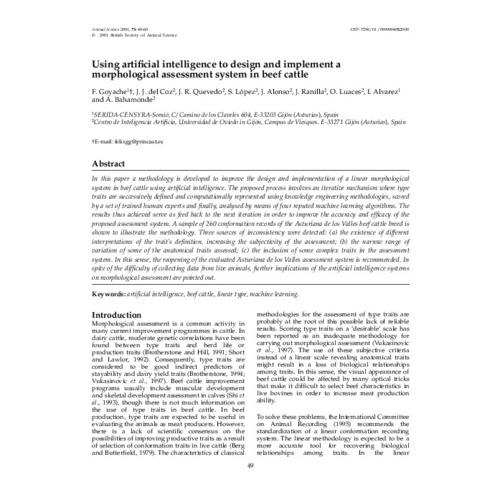Using artificial intelligence to design and implement a morphological assessment system in beef cattle
Palabra(s) clave:
Artificial intelligence
Beef cattle
Fecha de publicación:
Editorial:
Cambridge University Press
Citación:
Descripción física:
Resumen:
In this paper a methodology is developed to improve the design and implementation of a linear morphological system in beef cattle using artificial intelligence. The proposed process involves an iterative mechanism where type traits are successively defined and computationally represented using knowledge engineering methodologies, scored by a set of trained human experts and finally, analysed by means of four reputed machine learning algorithms. The results thus achieved serve as feed back to the next iteration in order to improve the accuracy and efficacy of the proposed assessment system. A sample of 260 conformation records of the Asturiana de los Valles beef cattle breed is shown to illustrate the methodology. Three sources of inconsistency were detected: (a) the existence of different interpretations of the trait’s definition, increasing the subjectivity of the assessment; (b) the narrow range of variation of some of the anatomical traits assessed; (c) the inclusion of some complex traits in the assessment system. In this sense, the reopening of the evaluated Asturiana de los Valles assessment system is recommended. In spite of the difficulty of collecting data from live animals, further implications of the artificial intelligence systems on morphological assessment are pointed out
In this paper a methodology is developed to improve the design and implementation of a linear morphological system in beef cattle using artificial intelligence. The proposed process involves an iterative mechanism where type traits are successively defined and computationally represented using knowledge engineering methodologies, scored by a set of trained human experts and finally, analysed by means of four reputed machine learning algorithms. The results thus achieved serve as feed back to the next iteration in order to improve the accuracy and efficacy of the proposed assessment system. A sample of 260 conformation records of the Asturiana de los Valles beef cattle breed is shown to illustrate the methodology. Three sources of inconsistency were detected: (a) the existence of different interpretations of the trait’s definition, increasing the subjectivity of the assessment; (b) the narrow range of variation of some of the anatomical traits assessed; (c) the inclusion of some complex traits in the assessment system. In this sense, the reopening of the evaluated Asturiana de los Valles assessment system is recommended. In spite of the difficulty of collecting data from live animals, further implications of the artificial intelligence systems on morphological assessment are pointed out
Colecciones
- Artículos [37321]
- Informática [870]
Ficheros en el ítem




